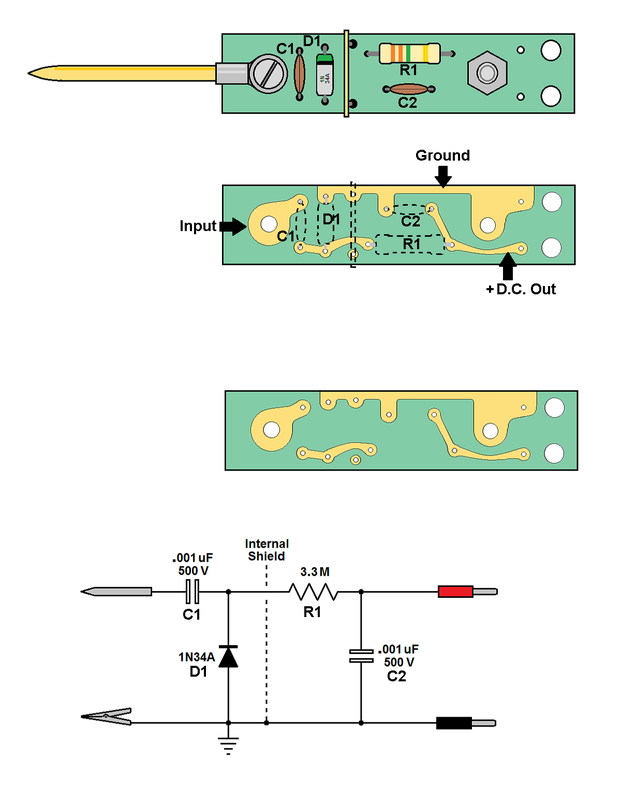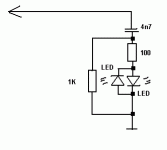In post
https://www.diyaudio.com/community/threads/signs-your-firstwatt-diy-is-unstable.186833/post-2536178
there is mention of an oscillation detector.
Again, in another thread it is further discussed
https://www.diyaudio.com/community/threads/the-little-oscillation-detector.215848/
The led's I chose have a forward voltage of 2v, but actually start glowing at 1.8-1.9 volts..
Today I hobbled it together as a proof of concept and wired directly to my signal gen.
I tried sine wave at 20k, 25k and 30k. Tried at all frequency's at 2, 2.5 and 3V
Swapped out a the 4n7 ceramic cap for a 4n7 mylar cap
Nothing I tried can get those buggers to light up...
Checked with the scope, and sure enough, the signal generator is chooching, but no joy...
Any ideas on what I could be missing ??
https://www.diyaudio.com/community/threads/signs-your-firstwatt-diy-is-unstable.186833/post-2536178
there is mention of an oscillation detector.
Again, in another thread it is further discussed
https://www.diyaudio.com/community/threads/the-little-oscillation-detector.215848/
The led's I chose have a forward voltage of 2v, but actually start glowing at 1.8-1.9 volts..
Today I hobbled it together as a proof of concept and wired directly to my signal gen.
I tried sine wave at 20k, 25k and 30k. Tried at all frequency's at 2, 2.5 and 3V
Swapped out a the 4n7 ceramic cap for a 4n7 mylar cap
Nothing I tried can get those buggers to light up...
Checked with the scope, and sure enough, the signal generator is chooching, but no joy...
Any ideas on what I could be missing ??
Attachments
Well, it looks almost identical to mine except I only have one LED and it's pointed towards ground. Can confirm my detector lit up when one of my amps showed some HF nastiness on output via oscilloscope.
There might be something about this design that only works with low Zout, not signal generators which are 600 ohms or whatever.
There might be something about this design that only works with low Zout, not signal generators which are 600 ohms or whatever.
Ok, at least this gives me something to chew on...
As I'm new to all of this, I didn't go crazy equipping my bench.
My function generator is one of those FY6900-60M 2-CH generators with counter...
Any ideas on how to verify the oscillation detector is working?
As I'm new to all of this, I didn't go crazy equipping my bench.
My function generator is one of those FY6900-60M 2-CH generators with counter...
Any ideas on how to verify the oscillation detector is working?
frequency
if you want to check it with 30KHz, increase cap value
oscillations are usually at much higher frequencies .......
if you want to check it with 30KHz, increase cap value
oscillations are usually at much higher frequencies .......
Try sending a signal from your generator through a preamp and amp, and put the tester on the speaker out posts? I'd add an 8R power resistor so the amp has a load as well.
Those shown above may work, sort of, but are crude and "deaf" insensitive, plus a heavy load to the circuit you are measuring.
They may detect a very strong oscillation at speaker out ... if that much.
I suggest you build the proper device where that one is derived from, an RF Probe.
Sensitive to millivolts RF and a high impedance load, think in the Megohm range, once input capacitor charges to peak value probe becomes an open circuit, only impedance present is multimeter input (1M to 10M)

https://www.robsradioactive.com/basic-rf-probe
The meter is, of course, any digital multimeter, set to 2VDC or 20VDC scale.
Diode is preferably Germanium for down to tens of mV sensitivity or a plain 1N400X for the strong "unstable amp" level expected signal.
In any case waaayyy more sensitive than getting tens of mA to straight light an LED 😱
They may detect a very strong oscillation at speaker out ... if that much.
I suggest you build the proper device where that one is derived from, an RF Probe.
Sensitive to millivolts RF and a high impedance load, think in the Megohm range, once input capacitor charges to peak value probe becomes an open circuit, only impedance present is multimeter input (1M to 10M)

https://www.robsradioactive.com/basic-rf-probe
The meter is, of course, any digital multimeter, set to 2VDC or 20VDC scale.
Diode is preferably Germanium for down to tens of mV sensitivity or a plain 1N400X for the strong "unstable amp" level expected signal.
In any case waaayyy more sensitive than getting tens of mA to straight light an LED 😱
The LED needs to lit for about 400ms so that it registers in your vision. This could be done with a multivibrator or 555 timer. Any one trigger will turn it on but it will time out if the input freq is too low.Nothing I tried can get those buggers to light up...
Checked with the scope, and sure enough, the signal generator is chooching, but no joy...
Any ideas on what I could be missing ??
You could implement something more elaborate with a micro such as ESP32 or 8266
Here are some other examples of oscillation sniffers:
https://www.diyaudio.com/community/threads/oscillation-sniffer.264871/#post-4122213
https://www.diyaudio.com/community/threads/oscillation-sniffer.264871/#post-4122213
My best OSCILLATION DETECTOR is a small AM battery powered plastic radio. I have used this as part of my tools to resolve problems for 50+ years. Tune to a blank station and listen to the noise or lack of noise (full large oscillators tend to have minimal modulation). Moving it around to locate the aera of the oscillators. It doesn’t load the circuit where a probe some times may will stop the oscillation.
Duke
Duke
Just an update,
My FY6900 signal generator voltage setting out is peak to peak (i think), not rms, so while I had it set from 2 to 3 volts I got zip on the led's...
Setting it to 3.5v and having at least 26k hz sign there was a tiny hair of led action! 3.6v a gave it yet more...
Raising the frequency to 30K hz allowed the led's to get brighter, and faster..
So very neet.. 2 leds, 2 resistors and one capacitor actually can create something of use!
Yea, I know... There are much better ways of doing this, but isn't that always the case ?
LTSpice says even with a 20v sign wave, at most the circuit is about 25mA and 4.2mW..
At 20 volts, my 96db speakers would be blasting me into orbit, me is thinking those loads above are barley perceptible...
What I liked was being able to detect anything just above our range of hearing. I figure any signals above 30K are a waste in an audio amp..
Guess I have to get a better grip on my o-scopes voltage measurement settings/display as I should have noticed this on moment one...
My FY6900 signal generator voltage setting out is peak to peak (i think), not rms, so while I had it set from 2 to 3 volts I got zip on the led's...
Setting it to 3.5v and having at least 26k hz sign there was a tiny hair of led action! 3.6v a gave it yet more...
Raising the frequency to 30K hz allowed the led's to get brighter, and faster..
So very neet.. 2 leds, 2 resistors and one capacitor actually can create something of use!
Yea, I know... There are much better ways of doing this, but isn't that always the case ?
LTSpice says even with a 20v sign wave, at most the circuit is about 25mA and 4.2mW..
At 20 volts, my 96db speakers would be blasting me into orbit, me is thinking those loads above are barley perceptible...
What I liked was being able to detect anything just above our range of hearing. I figure any signals above 30K are a waste in an audio amp..
Guess I have to get a better grip on my o-scopes voltage measurement settings/display as I should have noticed this on moment one...
- Home
- Design & Build
- Equipment & Tools
- Help with the Zen Mod oscillation detector
